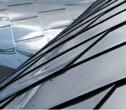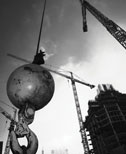Drive down the highway; almost every mansard has a colorful metal roof, and many large chain stores use some sort of metal roofing in their designs. Did you know that according to market research done by FMI, Raleigh, N.C., metal roofing is 22 percent of the commercial roofing market? Not only is installing metal roof systems a great opportunity for contractors, but there also is a great story to be told.
When most people think of metal roofing, they don't immediately think of energy savings. However, times have changed in the roofing industry. With the advent of attractive modern coatings that can effectively protect a roof for many decades and provide remarkable energy-saving properties, metal roofs are becoming quite "cool."
Metal roots
The origins of metal roofing in the U.S. can be traced to the country's infancy.
The U.S.' earliest metal used for roofing was imported. Although products such as lead, copper and tin came from Great Britain, zinc originally was imported from Belgium. But once mines and mills were established throughout the states, importing these materials no longer was necessary.
In 1819, the first metal shingles were created as small rectangles with folded edges that were lapped at the top and bottom and interlocked at the sides. However, it wasn't until the 1870s that metal shingles could be mass-produced. The process of stamping metal sheets was invented to facilitate interlocking edges, reduce the amount of lapping and prevent wind uplift. Many producers began to patent various patterns that were manufactured in iron, tin plate, galvanized steel and copper.
In 1828, Britain began preforming iron sheets, and the U.S. followed soon thereafter. By the mid-19th century, plants were producing corrugated roofing from plain and galvanized iron.
At the turn of the 20th century, the volume of steel and other metal manufacturing proved there would be an enormous increase in metal roofing. Metal was popular because not only could it be used for roofs, but it also could be applied in valleys, gutters and other rooftop detail areas. Because of its flexibility, metal can be used for weatherproofing a roof's junctures and angles, making it ideal for roofs that are curved or irregularly shaped.
Now, new enhancements to metal roofing, including coatings, sealants, fasteners, colors, textures and styles, have lowered the cost and caused metal roofing to increase in popularity.
The fourth R
Everyone has heard of the three R's of environmental sustainability: reduce, reuse and recycle. But perhaps it is time to add a fourth "R": roof.
According to the U.S. Green Building Council, buildings in the U.S. account for 36 percent of total energy use and 65 percent of electricity consumption. Additionally, research conducted by Oak Ridge National Laboratories, Oak Ridge, Tenn., shows 24 to 30 percent of cooling and heating loss is attributed to roofs. A properly designed and installed roof significantly can reduce national energy consumption.
Many factors come into play when designing a roof system, including climate, weather patterns, and building location and use. With so many variables, there is no single-component approach to roof system design suitable for all parts of the U.S. Roof color, material, insulation level, as well as the use of air and vapor retarders, always should be analyzed as a total system approach toward a sustainable roof design. When architects, specifiers, engineers and building owners focus on all these factors when developing a roof system, the end result can be a high-performing, energy-efficient system.
This energy efficiency can result in significant benefits for all parties involved in a roofing project. For example, the building owner will save money on heating and cooling costs; the architect will be recognized as a contributor to the green building movement; and the contractor can receive an incentive from the federal government for installing energy-efficient products. These all are possibilities when installing a high-performance metal roof system.
Understanding cool metal
How can metal roofing be considered cool when metal is clearly a significant heat agent? In simple terms, the less radiant heat a roof system absorbs and the more heat it reflects, the cooler it will be. This is why metal becomes so hot in the sun—it reflects heat.
Cool roofing is measured by two primary standards: total solar reflectance (TSR) and thermal emittance. TSR is a material's ability to reflect the sun's radiant energy into the atmosphere so the solar energy does not penetrate the building envelope. Emittance is defined as a material's ability to give off heat.
For example, a metal wrench lying in the sun will be hot to the touch, but a painted metal tool in the sun will be easier to handle. This is because the unpainted metal wrench has a low emittance, which means it does not effectively emit heat energy. Instead, it retains heat. In contrast, the painted tool has a high emittance and dissipates heat energy, allowing you to handle it comfortably. This principle holds true for a metal roof. When the sun sets, a painted metal roof surface emits a portion of the absorbed solar energy in infrared wavelengths into the night sky instead of transferring heat into the building. Consequently, the roof cools fairly quickly.
A painted roof's TSR rating mainly depends on the color and type of pigment used. Lighter colors with conventional pigmentation will achieve high TSR ratings; however, recent advancements in pigment technology have allowed the metal construction industry to achieve greater TSR ratings even with darker colors. A metal roof using specially formulated infrared-resistant pigments has considerably higher solar reflectance and infrared emittance regardless of the color when compared with conventional pigments used in traditional paint systems. An easy way to remember this is the higher the solar reflectance number (less absorbed heat energy = less heat transfer) and the higher thermal emittance percentage (the ability to emit the absorbed heat energy), the better.
Architects and building owners in search of cool roof properties now have a much wider color range from which to choose, including dark grays, greens, deep reds, browns and even black.
Think metal
As "green," or sustainable, building practices and the use of energy-efficient products become more prevalent, it only seems natural the most recycled product on the planet—one that retains its color for more than 20 years and has the ability to save energy—should be considered as an option: a painted metal roof using infrared-resistant pigmentation.
Ken Laremore is metal product manager for Carlisle SynTec Systems Inc., Carlisle, Pa., and Brian Partyka is executive vice president of business development for Drexel Metals Corp., Louisville, Ky.
Metal pros and cons
The benefits of metal roofing include:
- Durability and long warranties
- Longer service life compared with conventional roofing materials and reduced maintenance
- Fire, hail impact and wind ratings (including in high-velocity hurricane zones)
- Light weight provides structural savings and is ideal for retrofit applications
- Significant recycled content and 100 percent recyclability at the end of its useful life, reducing landfill waste and carbon foot-prints
- Energy-efficient, meets LEED® qualifications and works with solar mounting
The disadvantages of metal roofing include:
- Higher cost per square foot installed compared with conventional roofing products
- Slope and design restrictions compared with conventional low-slope roofing products
- Fewer certified installers than other roofing products
- Misperceptions, including the material will rust, be noisy and have an increased likelihood of being struck by lightning



